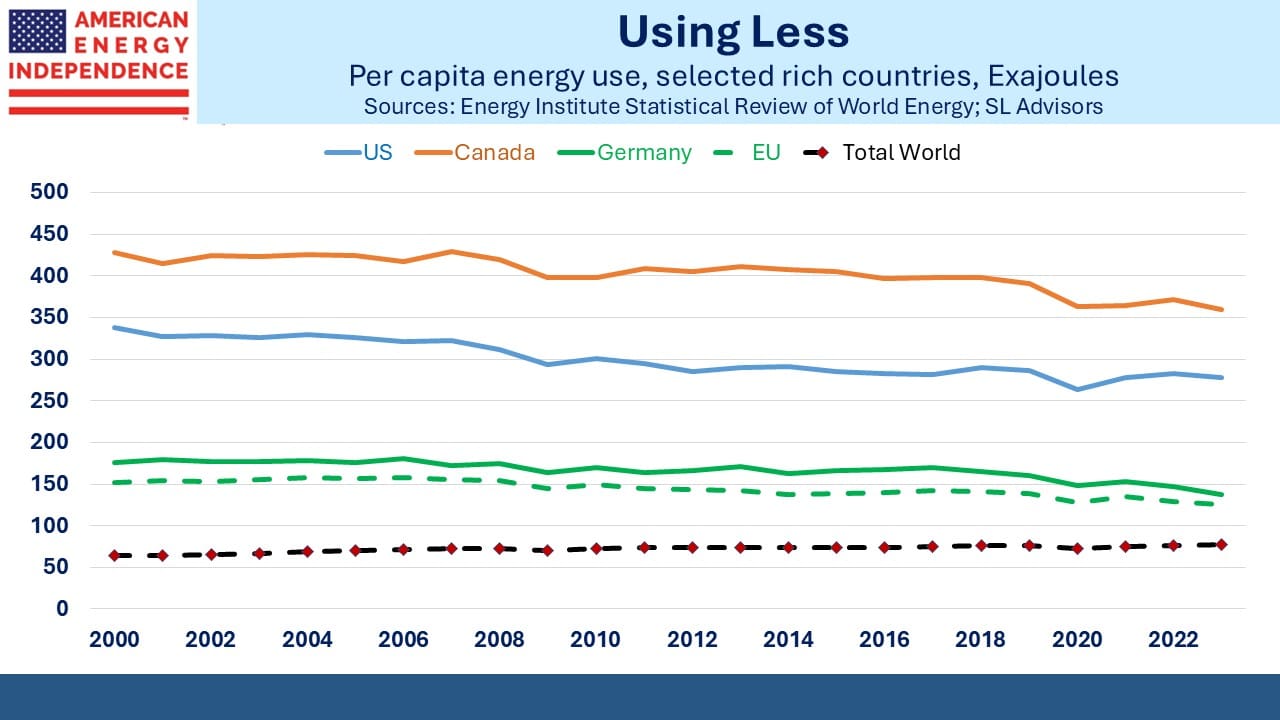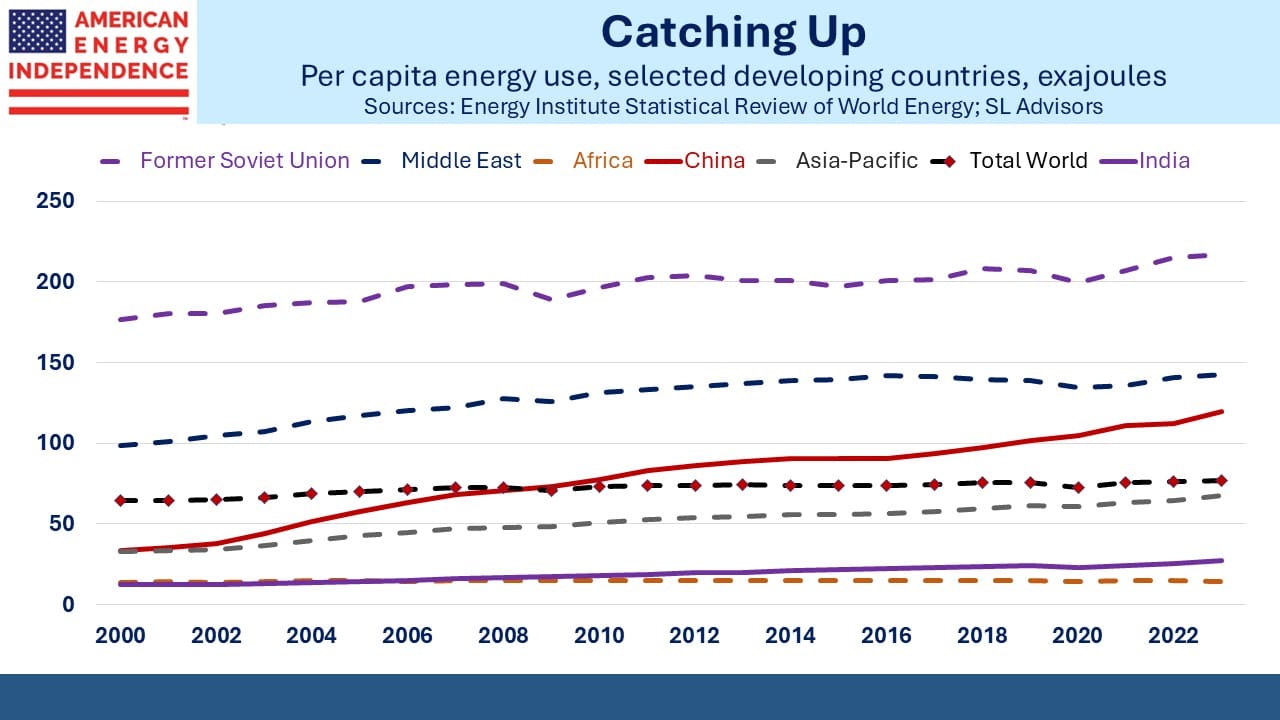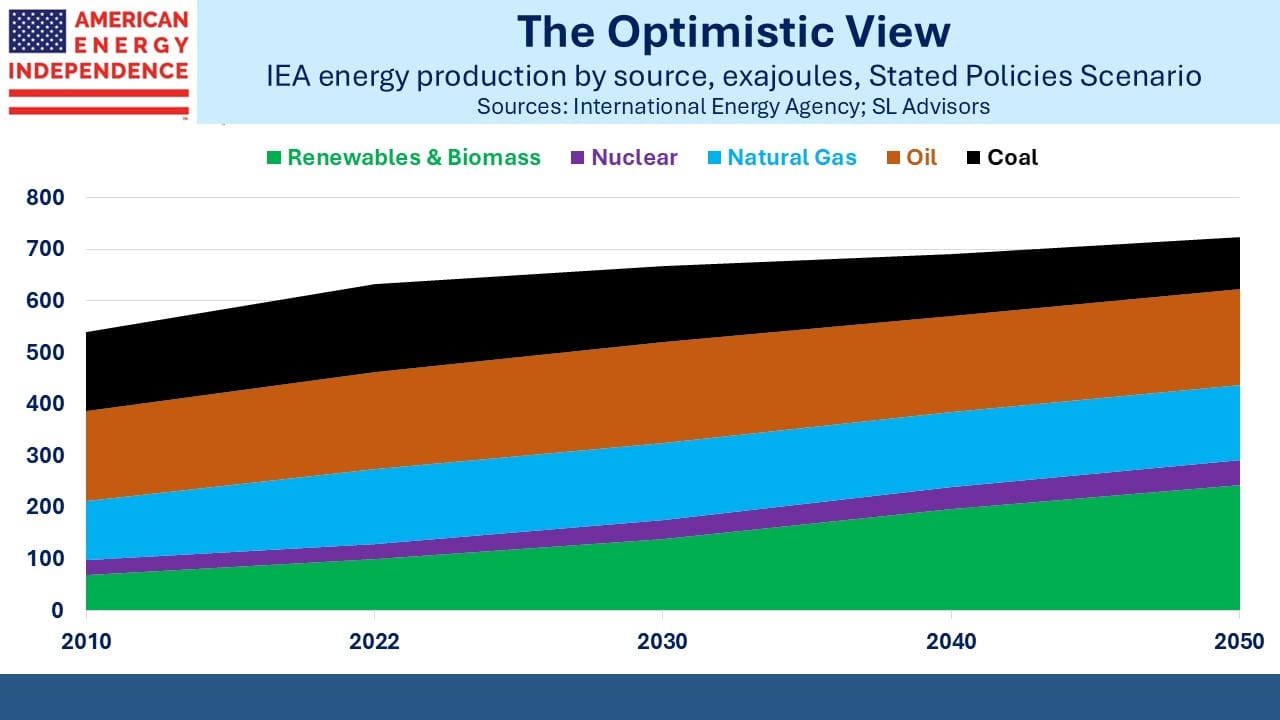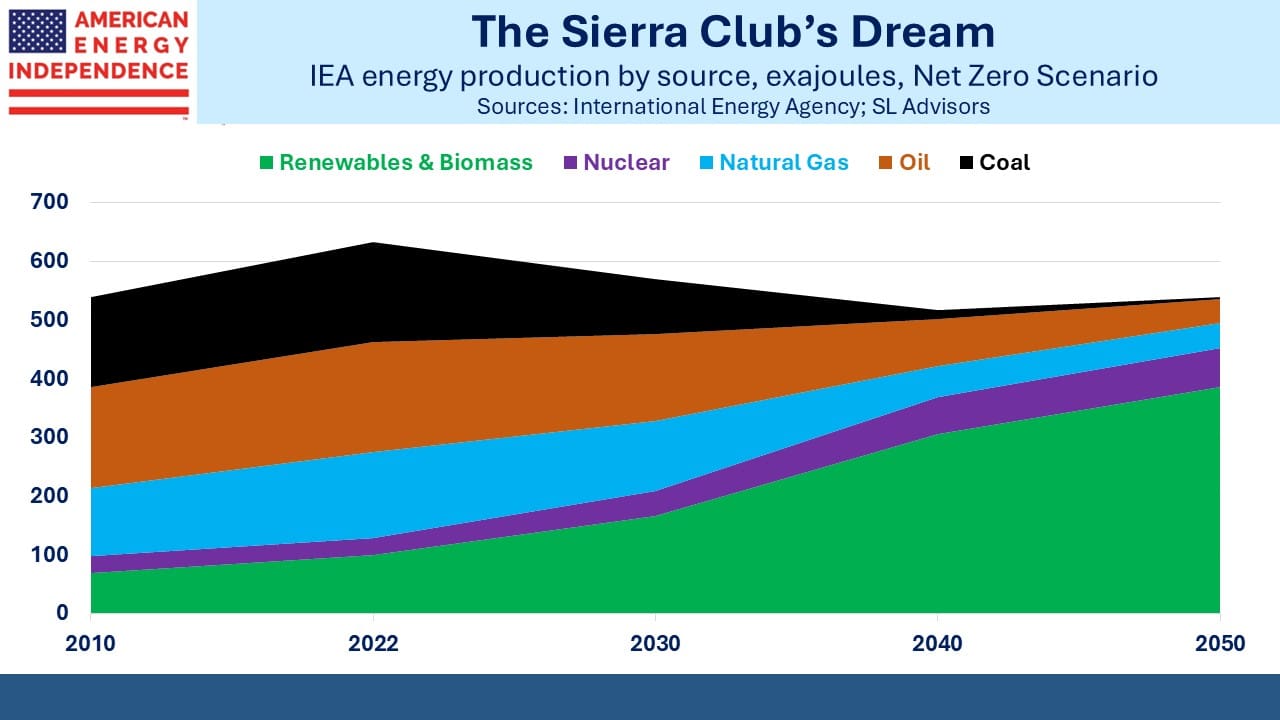Climate Vs Incomes

/
If a single chart can illustrate the challenges in reducing emissions, it’s the scatterplot below showing per capita energy use and GDP. Raising living standards requires more energy. The relationship between these two variables is hard to break. Richer countries consume more energy, and becoming richer requires more energy. Everyone wants to move up and to the right. They want to live more like Americans.
This is the fundamental challenge to moving the world off fossil fuels. Reducing emissions means paying more for energy as well as using less of it, which is completely at odds with the desire in developing countries to develop.
Per capita energy use varies enormously. Americans consume over 3X the global average. It’s not a perfect measure – China’s per capita energy consumption is close to the EU average even though incomes are less than half, which reflects the larger share of energy-intensive manufacturing in their economy as well as relatively low energy efficiency.
Canadians will be surprised to see what energy hogs they are. It’s not just their mix of economic activities. As my family in Ontario knows well, winter is long and cold north of the border, which pushes up energy consumption.
Getting richer means using more energy, and a substantial portion of the world’s population uses comparatively little. Moreover, concern about global warming tends to be greatest among rich countries, who are ironically better able to invest in mitigation against flooding or heatwaves.
An extended period of high temperatures in Pakistan was blamed on global warming, although for any specific weather event it’s impossible to know (see Energy By The Numbers). While scientists will point to the imperative to reduce emissions, Pakistanis will understandably favor more air conditioning, which means raising incomes and using more energy.
The International Energy Agency (IEA) publishes forecasts that are more aspirational nowadays, having dropped their original mission to provide unbiased analysis of energy markets. In their 2023 World Energy Outlook their Stated Policies Scenario, which is the closest to reality, projects 30 GigaTonnes (GTs, billions of metric tonnes) of CO2 emissions in 2050, down modestly from today’s 36 GTs. Even that includes heroic assumptions about declining coal use and sharply higher renewables.
The IEA calculates that if all the announced pledges on energy were implemented (their Stated Pledges Scenario), 2050 emissions would drop by two thirds to 12 GTs.
Their Net Zero Scenario shows just how implausible it is to eliminate emissions over the next twenty-six years. It includes an almost complete phaseout of coal by 2050, and an almost two thirds drop in natural gas consumption. It also assumes that total energy consumption is 15% lower by 2050 even though the world’s population is projected to be 9.7 billion by then (versus around 8 billion today).
Net Zero assumes nuclear power output would double. As fanciful as this scenario is, it wouldn’t be sufficient for the Sierra Club who wants the world to stop using nuclear as well.
The only way to square the circle is for rich countries who care the most about climate change to make enormous transfer payments (think $TNs annually) to poorer countries, to compensate for high-cost renewable energy. Climate extremists will counter that solar and wind are cheaper, but the contrary evidence is overwhelming. Germany has among the most expensive electricity in the world thanks to their big push into renewables (see Germany’s Costly Climate Leadership).
US electricity prices for households rose 6.2% last year as renewables gained market share (see Long Term Energy Investors Are Happy). This lowered the system’s overall capacity utilization. Solar and wind operate around 20-35% of the time. Their increased reliance means more back-up for when it’s not sunny or windy – typically large-scale batteries or more natural gas. The cost of solar and wind isn’t just the cost of using them to provide power. You have to include the back-up too.
Rich countries are not going to make the necessary transfer payments, which would be on a different scale than the current subsidies and tax breaks directed towards clean energy. Energy prices are politically sensitive – the Biden administration has been acutely sensitive to the oil market, even though allowing higher prices would boost the appeal of the alternatives.
The inherent conflict between raising billions of people out of poverty and reducing CO2 emissions is going to favor the former. As developing countries get richer, they’ll begin to share the climate concerns of western countries. There’s not much evidence that they do today. So we’ll use more natural gas along with every other source of fuel. The upside case is that policymakers make a serious effort to persuade China, India and others to use more natural gas and less coal.
US natural gas infrastructure looks like a good long term bet to us.
We have three have funds that seek to profit from this environment:

Important Disclosures
The information provided is for informational purposes only and investors should determine for themselves whether a particular service, security or product is suitable for their investment needs. The information contained herein is not complete, may not be current, is subject to change, and is subject to, and qualified in its entirety by, the more complete disclosures, risk factors and other terms that are contained in the disclosure, prospectus, and offering. Certain information herein has been obtained from third party sources and, although believed to be reliable, has not been independently verified and its accuracy or completeness cannot be guaranteed. No representation is made with respect to the accuracy, completeness or timeliness of this information. Nothing provided on this site constitutes tax advice. Individuals should seek the advice of their own tax advisor for specific information regarding tax consequences of investments. Investments in securities entail risk and are not suitable for all investors. This site is not a recommendation nor an offer to sell (or solicitation of an offer to buy) securities in the United States or in any other jurisdiction.
References to indexes and benchmarks are hypothetical illustrations of aggregate returns and do not reflect the performance of any actual investment. Investors cannot invest in an index and do not reflect the deduction of the advisor’s fees or other trading expenses. There can be no assurance that current investments will be profitable. Actual realized returns will depend on, among other factors, the value of assets and market conditions at the time of disposition, any related transaction costs, and the timing of the purchase. Indexes and benchmarks may not directly correlate or only partially relate to portfolios managed by SL Advisors as they have different underlying investments and may use different strategies or have different objectives than portfolios managed by SL Advisors (e.g. The Alerian index is a group MLP securities in the oil and gas industries. Portfolios may not include the same investments that are included in the Alerian Index. The S & P Index does not directly relate to investment strategies managed by SL Advisers.)
This site may contain forward-looking statements relating to the objectives, opportunities, and the future performance of the U.S. market generally. Forward-looking statements may be identified by the use of such words as; “believe,” “expect,” “anticipate,” “should,” “planned,” “estimated,” “potential” and other similar terms. Examples of forward-looking statements include, but are not limited to, estimates with respect to financial condition, results of operations, and success or lack of success of any particular investment strategy. All are subject to various factors, including, but not limited to general and local economic conditions, changing levels of competition within certain industries and markets, changes in interest rates, changes in legislation or regulation, and other economic, competitive, governmental, regulatory and technological factors affecting a portfolio’s operations that could cause actual results to differ materially from projected results. Such statements are forward-looking in nature and involves a number of known and unknown risks, uncertainties and other factors, and accordingly, actual results may differ materially from those reflected or contemplated in such forward-looking statements. Prospective investors are cautioned not to place undue reliance on any forward-looking statements or examples. None of SL Advisors LLC or any of its affiliates or principals nor any other individual or entity assumes any obligation to update any forward-looking statements as a result of new information, subsequent events or any other circumstances. All statements made herein speak only as of the date that they were made. r
Certain hyperlinks or referenced websites on the Site, if any, are for your convenience and forward you to third parties’ websites, which generally are recognized by their top level domain name. Any descriptions of, references to, or links to other products, publications or services does not constitute an endorsement, authorization, sponsorship by or affiliation with SL Advisors LLC with respect to any linked site or its sponsor, unless expressly stated by SL Advisors LLC. Any such information, products or sites have not necessarily been reviewed by SL Advisors LLC and are provided or maintained by third parties over whom SL Advisors LLC exercise no control. SL Advisors LLC expressly disclaim any responsibility for the content, the accuracy of the information, and/or quality of products or services provided by or advertised on these third-party sites.
All investment strategies have the potential for profit or loss. Different types of investments involve varying degrees of risk, and there can be no assurance that any specific investment will be suitable or profitable for a client’s investment portfolio.
Past performance of the American Energy Independence Index is not indicative of future returns.







Leave a Reply
Want to join the discussion?Feel free to contribute!